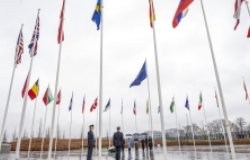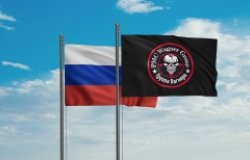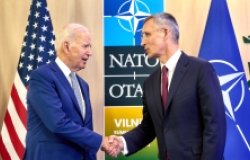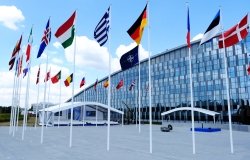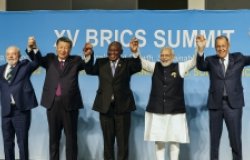228. Rediscovering the Black Sea: The Wider Southeast Europe in History, Politics, and Policy
The Black Sea, in many ways, is back. Neal Ascherson's evocative travel book, Black Sea (1995), sparked new interest among travelers to Crimea, the Caucasus, and the northern coast of Turkey. The Black Sea Trade Project at the University of Pennsylvania promises to uncover new archaeological evidence of the connections among Greek trading colonies around the sea's rim, as well as of ancient settlements long since covered by the sea's waters. Then there is news that the great deluge of Genesis and the Epic of Gilgamesh may actually have had its origins perhaps 8,000 years ago or so, when a great freshwater lake joined with the salty Mediterranean to form the strange ecological system of the Black Sea.
Among historians, social scientists, and policymakers, there is also renewed interest in the history of the sea and connections across it. The East-West Institute runs a strategy group on the politics of the Black Sea basin; the International Research and Exchanges Board (IREX) and the Woodrow Wilson Center are hosting the first ever symposium for younger scholars on the politics of the Black Sea zone in March 2001; and Duke University has a multiyear project, financed by the Ford Foundation, that examines connections across maritime basins, including the Black Sea. Since 1992, a multinational set of institutions has emerged to represent the Black Sea littoral states and their neighbors, among which is the Black Sea Economic Cooperation project (BSEC), with a secretariat, a parliamentary assembly, an environment program, a national bank, a university network, and a research institution, all based in Turkey, Romania, and Greece.
But why might one say that the Black Sea is "back"? The answer is that the current interest in the Black Sea zone - a swath of territory that I call "the wider southeast Europe" - is not so much the articulation of a new mental map of Europe's southeast reaches, but rather the rediscovery of a web of connections that did in fact exist in the past and that may yet exist again. Moreover, this system of linkages across the Black Sea was in fact of much longer duration, and may be far more powerful in the future, than our more recent ways of dividing up Europe's southeastern borderlands.
A decade after the demise of Communism, scholars, policymakers, and journalists still apply to Europe the same geographical descriptors that were born of the Cold War. Europe is usually sectioned into an integrating west, a reforming center, and a struggling east. But along the eastern periphery of the continent, the most striking division is increasingly one between a stable and cooperative northeast and a fractious and troubled southeast - a southeast that extends farther south and east than just the former Yugoslavia. There has been no shortage of external involvement in this region. The Aegean and Black seas are an alphabet soup of American and European projects, programs, processes, and partnerships, all designed to encourage good neighborly relations and prepare the way for entry into Euro-Atlantic institutions. Yet rarely has there been serious consideration of the way that these initiatives should fit together, what the realistic strategic goals of regional cooperation should be, and how the problems faced by countries such as Romania, Yugoslavia, Turkey, and Georgia might best be faced within a common framework rather than according to a mental cartography of Europe created after 1945. Understanding some of the common difficulties faced by the Balkans, Turkey, Ukraine, and the Caucasus, and identifying both the promise and impedances of regional cooperation are crucial to dealing with a zone that is quickly becoming Europe's own "near abroad."
The idea of a distinct Black Sea zone has implications for historians, political scientists, and policymakers alike. With few exceptions, the history of southeast Europe is still written through a largely national lens, with the emergence of distinct, self-conscious nations as the central narrative and the establishment of national states as the historiographical telos. History-writing in the national mode, however, obscures what has in fact been the dominant social fact of southeast Europe's long history: hybrid identities, overlapping allegiances, and multiple definitions of what constitutes the community - not the ancient hatreds and age-old animosities that recent visitors such as Robert Kaplan have normally seen. Putting the Black Sea at the center of our historical gaze, treating the sea as a link rather than a barrier, is one way of encouraging this kind of scholarship. Some of the most innovative writing on the Americas, the Mediterranean, and southeast Asia in recent years has been based on the idea of maritime peripheries as integrated units, an approach that owes much to Fernand Braudel's magisterial treatment of the Mediterranean in the early modern period. The study of the Black Sea can do the same for our understanding of the interconnected histories of the wider southeast Europe.
Putting the Black Sea at the center of research can also help to integrate regional histories that are today often seen as separate. The history of Ukraine is rarely discussed in connection with the history of the Balkans. Turkey disappears from the national histories of Balkan states, bit by bit, after the 1820s. The history of the south Caucasus rarely intersects with that of the south Balkans. There is, however, a story to be told about connections across the sea, about cultural influences, about the movement of populations, about relationships between communities and states. There has long been a tradition of writing in this vein about other areas of Europe and Eurasia, for example, studies of the Polish-Lithuanian borderlands, the Siberian and north Caucasian frontiers in Russian history, the study of the Anatolian frontier marches in Ottoman history. That approach might equally be applied to the Black Sea.
Finally, examining the Black Sea as a regional space has the added benefit of helping us move beyond a place called "Eastern Europe" with two capital "E's." Scholars such as Larry Wolff have argued insightfully that the invention of "Eastern Europe" was not simply a process that began in 1945, but rather part of a long history of seeing the east as less developed, less civilized, and less European than the center and the west, a history that Wolff sees as beginning during the Enlightenment. But the idea of a distinct region called "Eastern Europe," running from Poland to Bulgaria, is of far more recent vintage. The concept would have made little sense to writers even in the early twentieth century. Other geographical divisions and labels would have been far more intelligible then - the "Near East," for example, a phrase that, well into the twentieth century, included Romania, the south Balkans, Turkey, and the south Caucasus as part of a single regional space. The history of Europe's east, in other words, is not the history of a place called "Eastern Europe," and reorienting our geographical gaze, focusing on the sea and its connections rather than on nation-states and their boundaries, can be a useful window into the past.
What I am emphatically not saying, though, is that there is something called a "Black Sea identity" - although whether there was or not historically is still a matter for investigation. Putting the Black Sea at the center of research is not about seeking out a common identity. It is, however, about understanding connections. Indeed, if writing regional history were really predicated on there being a common identity, why did anyone ever write a history of places called "Eastern Europe" or "the Balkans" sets of identities that, if they ever existed at all, are very recent indeed?
Redrawing our mental map of the southeast also has implications for political scientists. In particular, it links up with ongoing discussions about the role of area studies in political science research and education. For more than a decade, specialists on eastern Europe have spoken of the need to rethink what the "area" in area studies actually means. But in many ways, scholars have substituted the term "transition" for "area" yet defined the geographical boundaries in the same way. Given the vast differentiation across the post-communist lands, though, the term "transition" may well obscure more than it illuminates. Only a few years hence, "transition" may look as cliched an adjective as "developing."
Research on the Black Sea zone is one alternative way of dividing up the area that area studies experts study. Most of the countries of the region are weak states. Most are multinational, not just multiethnic, with distinct historical nations sharing one piece of territory. All are on the periphery of Europe, laggards in the race for membership in most European and Euro-Atlantic institutions. Many have been beset by territorial separatism and interethnic strife. All face the problem of endemic corruption. All these questions are of interest to political scientists, but interestingly, the norm has been to compare states outside the region - Latin America, say, with central Europe - rather than to look for comparisons among states from the same neighborhood. There has been no major work, for example, that explicitly compares political transition in Greece and Romania. The role of the military in politics might be examined in Georgia, Turkey, and Armenia. So powerful has the idea of "post-communism" been in our mental mapping of eastern Europe that we have tended to look far afield for comparable cases when in fact enlightening comparisons might be made in eastern Europe's own backyard.
This is not to say that geography should necessarily trump regime type (although there is some research to suggest that geography might be a far more powerful predictor of political and economic outcomes than is often admitted). But around the Black Sea there are a host of countries that share common domestic problems and foreign policy predicaments that cry out for comparative study. All that is required is that analysts think creatively about what countries to group together, what languages and historical knowledge are necessary for good research, and what areas the area studies of the future ought to cover.
All of this also has important implications for policy. First, outside governments should take indigenous forms of region-building more seriously. The Black Sea Economic Cooperation is often dismissed as little more than a talking shop, but it is the most highly institutionalized form of cooperation in all of eastern Europe. BSEC is hardly likely to become another European Union anytime soon, yet it does provide a forum which, so far, has been largely ignored by both the EU and the US. Indeed, forms of region-building in southeast Europe that have been strongly supported by external players - such as the Stability Pact and the Southeast European Cooperative Initiative - have more often sidelined BSEC than attempting to use and strengthen the established institutions that BSEC offers.
A more informal mode of cooperation, the so-called GUUAM group (Georgia, Ukraine, Uzbekistan, Azerbaijan, Moldova) has received far more attention, especially from the United States. GUUAM arose after 1998 due to a set of hard-nosed strategic/military concerns that brought the (initially four) countries together: first, revising the flank limits of the Conventional Forces in Europe Treaty; and second, making sure that the Russian military deployments in Moldova and Georgia come to an end. GUUAM is now at a crossroads. Its first summit meeting was set for this spring in Kyiv, but has since been postponed. Like BSEC, however, it brings together a set of countries that span the Black Sea and that are not necessarily thought of as a distinct unit.
There is also a form of regional cooperation that has received very little attention at all but is crucial for the future peace and stability of the Black Sea zone. Call it "TAKO" - cooperation among the unrecognized republics of Transnistria, Abkhazia, Karabakh, and South Ossetia. These are four de facto states whose ability to govern themselves and control their own territory is, in some cases, nearly as impressive as that of the states of which they are still nominally a part. They do cooperate with each other, by sending official delegations back and forth, signing trade and production agreements between firms, and buying and selling weaponry. Little, though, is known about the internal workings of these phantom entities or how their coordination of policies contributes to the continued weakness of Georgia, Moldova, and Azerbaijan.
There is one other policy dimension that is worth mentioning: the policy regarding the structure of government-sponsored funding programs for research on eastern Europe and the former Soviet Union. There is usually an iron budgetary curtain between these two regions, the former Communist states of central Europe and the Balkans (including the Baltic states), and most of the successor states to the Soviet Union. Even though there is plenty to be gained from research programs that combine the two regions - or bits of them - funding programs normally require that scholars define themselves as either "east Europeanists" or "post-Sovietologists." That division, however, discourages genuinely innovative research on topics that stretch across those zones. The study of weak states and political transition, for example, has much to gain from studying Albania as well as Georgia. Regional policy and local government within states could be fruitfully studied by comparing Ukraine with Romania. As the twenty-eight "transition countries" keep moving in wildly divergent directions - consolidating forms of government ranging from liberal democracies to dynastic authoritarian regimes - continuing to define the boundaries of regional studies in the same way as in the past is no longer serviceable. So far, however, IREX and the Woodrow Wilson Center are the only major funding entities that actively encourage specialists to divide up Europe's eastern lands in new and innovative ways. Research on the Black Sea is one way of recasting those boundaries.
Charles King spoke at an EES Discussion on February 14, 2001. The above is a summary of his presentation. Meeting Report #228.
About the Author


Global Europe Program
The Global Europe Program is focused on Europe’s capabilities, and how it engages on critical global issues. We investigate European approaches to critical global issues. We examine Europe’s relations with Russia and Eurasia, China and the Indo-Pacific, the Middle East and Africa. Our initiatives include “Ukraine in Europe” – an examination of what it will take to make Ukraine’s European future a reality. But we also examine the role of NATO, the European Union and the OSCE, Europe’s energy security, transatlantic trade disputes, and challenges to democracy. The Global Europe Program’s staff, scholars-in-residence, and Global Fellows participate in seminars, policy study groups, and international conferences to provide analytical recommendations to policy makers and the media. Read more


